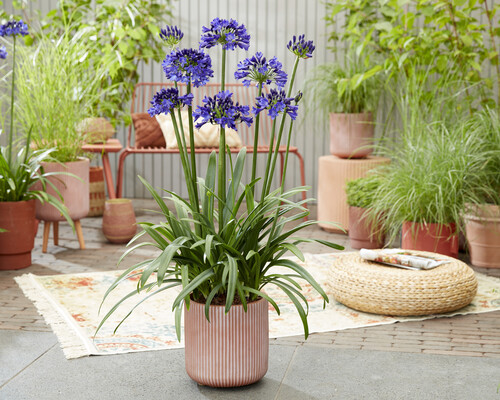Mastering the Art of Agapanthus Treatment: Crucial Actions for Healthy And Balanced Growth and Dynamic Blooms
In the world of gardening, the growing of agapanthus stands as a rewarding undertaking for those that look for to nurture these sophisticated flowering plants. With their striking blossoms and stylish vegetation, agapanthus has actually recorded the attention of gardeners worldwide. However, attaining optimum growth and vibrant blooms requires a nuanced approach that includes numerous important actions. From selecting the right selection to understanding trimming techniques, the trip towards growing growing agapanthus plants is diverse and holds the key to opening the complete capacity of these herb gems.
:max_bytes(150000):strip_icc()/agapanthus-growing-guide-7368912_06ba-bf1fa268243b451387986fbd1e2433b3.jpg)
Choosing the Right Agapanthus Selection

When selecting the right Agapanthus selection for your yard, take into consideration aspects such as environment suitability, blossom color, and development practice. In addition, take into consideration the climate in your area to make sure the Agapanthus selection you choose can thrive in your specific conditions. Understanding the growth behavior of different Agapanthus selections is essential for proper placement within your yard.
Ideal Growing Problems
Taking into consideration the ideal ecological demands is important for effective Agapanthus cultivation. Agapanthus prospers in well-draining soil with a slightly acidic to neutral pH degree. When planting, select an area that gets full sunshine to partial color. In hotter climates, supplying some afternoon color can avoid scorching of the fallen leaves. Agapanthus plants are sensitive to cool temperatures and should be shielded from frost during cold weather.
To guarantee healthy and balanced growth and dynamic blooms, plant Agapanthus light bulbs at a deepness of about 2-4 inches and area them 8-12 inches apart. Including natural issue, such as garden compost, to the dirt can improve drain and fertility, advertising robust origin growth. Mulching around the base of the plants assists maintain dampness and suppresses weed growth. Regular watering is critical, especially during the expanding season, to maintain the soil consistently wet but not soaked.
Watering and Feeding Tips
Keeping appropriate wetness degrees and offering crucial nutrients are essential aspects in the care program for Agapanthus plants. It is essential to strike a balance when it comes to sprinkling Agapanthus. These plants choose consistently wet soil but are vulnerable to root rot if overwatered. Throughout the expanding period, water deeply as soon as a week, ensuring the dirt is well-draining to avoid waterlogging. In hotter environments or during periods of drought, even more constant watering might be essential to keep the soil equally wet. Nonetheless, reduce watering in the wintertime to stop water logged conditions.
Feeding Agapanthus is essential for promoting healthy and my company balanced development and prolific blooms. Use a well balanced plant food, such as a 10-10-10 formula, in the early springtime as new growth arises. By adhering to these watering and feeding pointers, you can ensure your Agapanthus plants flourish and create vivid, durable blooms.
Trimming Methods for Agapanthus
Pruning Agapanthus plants at the proper times and with appropriate strategies is crucial for keeping their wellness and promoting ideal development and blooming. The ideal time to prune Agapanthus is in late winter months or very early springtime prior moved here to new development arises.
Deadheading invested blossoms can also redirect the plant's energy into generating more flowers rather than establishing seeds. If you desire to accumulate seeds for breeding, leave some flowers to dry and fully grown on the plant.
Bear in mind to use tidy, sharp devices to make exact cuts and minimize the danger of introducing illness. Agapanthus. Regular pruning will aid maintain your Agapanthus looking cool and healthy while making certain a bountiful display screen of attractive flowers
Handling Usual Parasites and Illness
After making sure appropriate trimming techniques for Agapanthus, it is vital to deal with common insects and diseases that can impact the wellness and vigor of these plants. One common bug that influences Agapanthus is the Agapanthus gall midget.
One more common concern is fungal leaf place, which provides link as dark lesions on the fallen leaves. To avoid fungal conditions, make sure great air blood circulation around the plants, avoid overhanging watering, and get rid of any infected fallen leaves quickly. Furthermore, Agapanthus plants can experience origin rot if they are grown in improperly draining soil. To stop this, plant Agapanthus in well-draining soil and stay clear of overwatering. By being alert and taking prompt activity against parasites and illness, you can help your Agapanthus plants flourish and create dynamic blossoms.

Conclusion
To conclude, understanding the art of agapanthus care includes selecting the right variety, giving ideal growing conditions, proper watering and fertilizing, proper pruning strategies, and resolving common pests and illness. By complying with these crucial actions, you can ensure healthy development and dynamic blossoms for your agapanthus plants. Remember to regularly keep track of and preserve your plants to promote their total health and longevity.
To guarantee healthy and balanced growth and dynamic flowers, plant Agapanthus bulbs at a depth of regarding 2-4 inches and room them 8-12 inches apart. By complying with these watering and fertilizing suggestions, you can ensure your Agapanthus plants grow and produce dynamic, lasting flowers.
One common pest that affects Agapanthus is the Agapanthus gall midge. In addition, Agapanthus plants can endure from origin rot if they are grown in inadequately draining soil. By following these vital actions, you can make certain healthy development and vivid blossoms for your agapanthus plants.